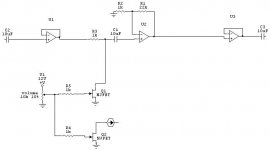I wanted to build a dc operated volume control using one pot to control 2 channels,I came up with a circuit using fets and op amps,does anyone have ideas,I dont want to use the national chip


If you give us your diagram we can at least point out the areas for improvement 😉
Did you look in the VCA's from THAT corporation?
Jan Didden
Did you look in the VCA's from THAT corporation?
Jan Didden
Member
Joined 2004
DC controlled pre-amp
Steven344: I built a very good pre-amp from the Analog Devices SSM2164(Quad VGA).You can implement full Class A operation by adding a single resistor.You can follow the circuit in figure 24 as a good starting point.
Regards Bob C.
http://www.analog.com/UploadedFiles/Data_Sheets/15183786ssm2164.pdf
Steven344: I built a very good pre-amp from the Analog Devices SSM2164(Quad VGA).You can implement full Class A operation by adding a single resistor.You can follow the circuit in figure 24 as a good starting point.
Regards Bob C.
http://www.analog.com/UploadedFiles/Data_Sheets/15183786ssm2164.pdf
preamp
Here is my preamp,Have not built it yet.My idea is to use one pot to control 2 channels,First op amp is unity gain to isolate the source second op amp is for gain and third is buffer.The fets provide a variable resistence to ground after the 1 k resistor before the gain circuit.I would like anyones input as to if its a good circuit

Here is my preamp,Have not built it yet.My idea is to use one pot to control 2 channels,First op amp is unity gain to isolate the source second op amp is for gain and third is buffer.The fets provide a variable resistence to ground after the 1 k resistor before the gain circuit.I would like anyones input as to if its a good circuit

Attachments
Interestingly!
Two initial comments:
If you use the FET in the gain opamp feedbak path (instead of R1 for instance) you can delete the U1 buffer, another less source of distortion! Same for U3, totally superfluous.
FETS are non-linear in this application. The accepted way of using them is to keep the signal across the FET less then a few 100 mV, and also to inject about half of the signal across the FET to its gate adding to the control voltage. You often see this in audio signal generators where a low distortion means is needed to stabilise the level in a control feedback loop.
Jan Didden
Two initial comments:
If you use the FET in the gain opamp feedbak path (instead of R1 for instance) you can delete the U1 buffer, another less source of distortion! Same for U3, totally superfluous.
FETS are non-linear in this application. The accepted way of using them is to keep the signal across the FET less then a few 100 mV, and also to inject about half of the signal across the FET to its gate adding to the control voltage. You often see this in audio signal generators where a low distortion means is needed to stabilise the level in a control feedback loop.
Jan Didden
- Status
- Not open for further replies.
